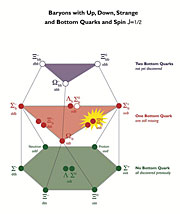- Number 344 |
- August 22, 2011
Fermilab experiment discovers a heavy relative of the neutron

The CDF collaboration discovered
the neutral Xi-sub-b, highlighted
in this periodic table of baryons.
Scientists of the CDF collaboration at DOE’s Fermi National Accelerator Laboratory have discovered a new particle, the neutral Xi-sub-b. The particle is the latest entry in the periodic table of baryons, and the finding strengthens our understanding of how quarks form matter.
Baryons are particles formed of three quarks, the most common examples being the proton and the neutron. The neutral Xi-sub-b contains a strange quark, an up quark and a bottom quark. It is about six times heavier than the proton and neutron. The particle is produced only in high-energy collisions and very difficult to observe. Once produced, the neutral Xi-sub-b travels only a fraction of a millimeter before it decays into lighter particles.
Combing through almost 500 trillion proton-antiproton collisions produced by Fermilab's Tevatron particle collider, CDF scientists isolated 25 examples in which the particles emerging from a collision revealed the distinctive signature of the neutral Xi-sub-b. The CDF collaboration submitted a paper that summarizes the details of its discovery to the journal Physical Review Letters.
Measuring the properties of baryons allows scientists to test and improve models of how quarks interact at close distances via the strong nuclear force, as explained by the theory of quantum chromodynamics (QCD). Scientists use powerful computers at Fermilab and other DOE national laboratories to simulate quark interactions and understand the properties of particles comprised of quarks.
[Kurt Riesselmann, 630.840.5681,
kurtr@fnal.gov]
